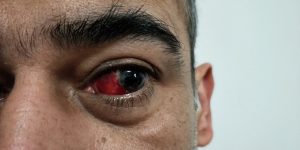 Also known as a subconjunctival hemorrhage, a broken blood vessel in your eye is typically a harmless condition (although see below) that clears up within one to three weeks.
Also known as a subconjunctival hemorrhage, a broken blood vessel in your eye is typically a harmless condition (although see below) that clears up within one to three weeks.
The official name for a broken blood vessel in your eye is a subconjunctival (sub-kon-junk-TIH-vul) hemorrhage. Symptoms of this condition include:
- Bright red patch on the white of the eye
- A slight sense of fullness in the eye or under the lid
- Very mild irritation of the eye
A subconjunctival hemorrhage (sub-kun-JUNK-tih-vul HEM-uh-ruj) occurs when a tiny blood vessel breaks just underneath the clear surface of your eye (conjunctiva). The conjunctiva can’t absorb blood very quickly, so the blood gets trapped. You may not even realize you have a subconjunctival hemorrhage until you look in the mirror and notice the white part of your eye is bright red.
A subconjunctival hemorrhage often occurs without any obvious harm to your eye. Even a strong sneeze or cough can cause a blood vessel to break in the eye. You don’t need to treat it. Your symptoms may worry you. But a subconjunctival hemorrhage is usually a harmless condition that disappears within two weeks or so.
 Subconjunctival is the term used to describe the space located just beneath the conjunctiva (the clear surface of your eye). The term hemorrhage refers to the breakage of tiny blood vessels.
Subconjunctival is the term used to describe the space located just beneath the conjunctiva (the clear surface of your eye). The term hemorrhage refers to the breakage of tiny blood vessels.
Most people do not realize they have a broken blood vessel in their eye until someone tells them or they look in a mirror. This condition is not painful, and typically develops after blunt trauma to the eye. In most cases, treatment is not needed for a subconjunctival hemorrhage.
Symptoms and Causes of a Broken Blood Vessel on the Front of the Eye:
Besides the visible bleeding between the sclera (the white part of the eye) and conjunctiva, many people describe a scratchy or itchy feeling on the surface of the eye. Pain is generally non-existent or minimal, and there is no change in vision, although there may be some discomfort.
The conjunctiva contains several nerves and tiny blood vessels. These blood vessels (which are barely visible until they become inflamed and enlarged) are fragile, and their walls can easily break. Events that can cause blood vessels on the front of the eye to break include:
- Sneezing
- Coughing
- Vomiting
- Straining
- Poorly controlled blood pressure
- Crying
- Rubbing your eyes
- Blunt trauma
- Increased intracranial or intraocular pressure
- Shaken baby syndrome (often the case in children with subconjunctival hemorrhages in both eyes)
This is not an exhaustive list; often the exact cause of the injury is unknown. There are several factors that can increase the risk of a broken blood vessel on the front of the eye. For example, medications and supplements such as warfarin, aspirin, Plavix, and high doses of vitamin E can thin the blood and make it easier for hemorrhages to occur.
Although rare, St. John’s wort, ginkgo biloba, ginger, and cayenne can also increase one’s risk if taken in high doses. Occasionally, blood vessels on the front of the eye will break due to conjunctivitis (eye infection) and high blood pressure.
Risks of a Broken Blood Vessel in Your Eye:
If you have noticed the appearance of blood in your eye, it may be advisable for you to seek medical attention. While a broken blood vessel in your eye is seldom dangerous, hyphema (blood in the front chamber of the eye, between the cornea and the iris) is potentially a more serious condition, with more serious consequences.
Diagnosing a Broken Blood Vessel in Your Eye:
If you have a broken blood vessel in your eye, you should contact your eye doctor and schedule an appointment. In most cases, a simple eye exam is enough for an eye doctor to properly diagnose a subconjunctival hemorrhage.
If the cause is unknown, however, your doctor may perform a series of tests to rule out other eye conditions that may be causing the hemorrhaging. Your eye doctor will ask you about your medical history (medications included), and about any activities that may have induced the rupture.
If trauma is the cause, a more thorough examination will be performed to ensure that damage has not occurred to other structures in your eye.
Treatment of a Broken Blood Vessel in Your Eye:
In most cases, treatment is not needed for a subconjunctival hemorrhage. If you are experiencing pain or discomfort, over-the-counter pain medications such as Tylenol may be recommended.
Aspirin and related products should be avoided due to their blood-thinning side effects. Those who take aspirin or anticoagulants for a medical condition should talk with their eye doctor to determine whether it is safe to continue using these during the healing process.
Over-the-counter artificial tears may also help reduce any irritation. If the subconjunctival hemorrhage is due to trauma, other treatment may be necessary to promote healing. If an infection is present, antibiotic eye drops or ointment may be prescribed.
Typically, the condition clears up on its own within two or three weeks, without long-term problems.
Preventing Broken Blood Vessels in Your Eye:
Broken blood vessels in your eye can sometimes be prevented. To avoid eye injuries, wear protective eyewear during athletic events or whenever you are exposed to environments that involve flying particles (such as dust) or bright sunlight.
If you are experiencing recurrent broken blood vessels in your eye, seek medical attention to rule out underlying blood-clotting conditions. Treatment of an underlying medical condition can prevent symptoms such as broken blood vessels.
Questions to Ask Your Doctor:
- How severe is my hemorrhage?
- How long will my eye be red?
- What can I do to prevent this from happening again?
- Which treatment options do I have?
- Which complications may arise if my eye is left untreated?
- Could this harm my vision in the future?
The exact cause of subconjunctival hemorrhage is currently unknown. However, sudden increases in blood pressure from violent coughing, powerful sneezing, heavy lifting, or even intense laughing may generate enough force to cause a small blood vessel in your eye to burst. Occasionally, the use of blood-thinning medications or even aspirin can cause the blood vessel to burst. Severe eye infections, eye or eyelid surgery, or roughly rubbing your eye can also lead to a case of subconjunctival hemorrhage.
Broken blood vessels generally treat themselves. You don’t even need to wear an eye patch! The conjunctiva slowly absorbs the blood over the course of 10-14 days. Recovery is usually complete, without any long-term complications—much like a mild bruise under the skin. Although eye drops cannot help repair the broken blood vessels, they can soothe the eyes of irritation.
If the condition does not clear up within one to two weeks, schedule a visit to your eye doctor who can better identify the problem and propose a treatment that’s right for you.
The content of this article is for general informational awareness purposes only, and is not intended to be a substitute for professional advice, diagnosis, or treatment. Please consult your eyecare doctor or physician for actual advice, diagnosis, or treatment. If you think you may have a medical emergency, call your doctor or 911 immediately.
We want our community to be a useful resource for our users but it is important to remember that the community is not moderated or reviewed by doctors and so you should not rely on opinions or advice given by other users in respect of any healthcare matters.
Always speak to your doctor before acting and in cases of emergency seek appropriate medical assistance immediately. Use of our community is subject to our Terms of Use and Privacy Policy and steps will be taken to remove posts identified as being in breach of those terms.
